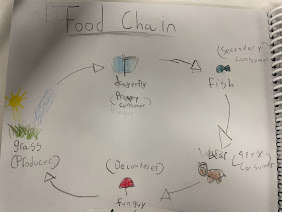Blog Post 12
Nov. 14th - 18th
Learning Outcomes
Science:
Describe the living and nonliving components of a wetland ecosystem and the interactions within and among them.
-Identify the roles of different organisms in the food web of a pond: Producers, Consumers, and Decomposers
-Draw diagrams of food chains and food webs
What Did Students Do?
Students learned about producers, primary consumers, secondary consumers, and decomposers. They created a visual journal page listing characteristics of each.
They began to explore different types of food chains and some students have started to create visual journal pages around these.
Family Connections
Ask students about producers, consumers, and decomposers. Have them provide examples.
I Can Statements (Each student can...)
I can identify the roles of different organisms in the food web of a wetland
I can draw and interpret diagrams of food chains and food webs
Upcoming Dates
Nov. 21 - 25 - Scholastic Book Fair
Nov. 24 (3:30-7:00 pm) - Parent Teacher Conferences (Online)
Nov. 25 (8:00-1:00 om) - Parent Teacher Conferences (Online)



Comments
Post a Comment